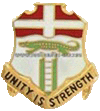

 |
The 6th Infantry Division |  |
|---|
The 6th Infantry Division was a unit of the United States Army in World War I, World War II, and the last years of the Cold War. It was activated in November, 1917 with the 11th & 12th Infantry Brigades, the 51st, 52d, 53d & 54th Infantry Regiments, the 16th, 17th & 18th Machine-Gun Battalions, and the 3d, 11th & 78th Field Artillery Battalions. The division was deployed for WW I in June, 1918 and returning to the United States June, 1919. The division saw 43 days of combat and suffered 386 casualties: (KIA-38; WIA-348). The division was deactivated on September 30th, 1921 at Camp Grant, Illinois.
The 6th Infantry was again activated at Fort Jackson, South Carolina on October 12th, 1939 and then moved to Fort Benning, Georgia for a series of maneuvers participating in the Sabine, Louisiana – Texas Maneuver in 1940. They then moved to Fort Francis E. Warren, Wyoming , Fort Leavenworth, Kansas, and Fort Leonard Wood, Missouri through mid-1941. They participated in maneuvers in Tennessee and moved for a training cycle at the Desert Training Center at Camp Young until December of 1942. The regiment was then staged at Camp San Luis Obispo, California on March, 23rd, 1943 for deployment.The regiment departed from California and arriving in Hawaii on September 9th, 1943. They departed Hawaii on 1944-01-26, and arrived at Milne Bay, New Guinea on February 7th, 1944 to participate in the New Guinea Campaign of World War II, moving to Toem on June 6th, 1944. At this time the division consisted of the 1st, 20th, & 63rd Infantry Regiments, the 1st, 51st, 53rd, & 80th Field Artillery Battalions, the 6th Signal Company, 706th Ordnance Company, 6th Quartermaster Company, 6th Reconnaissance Troop, 6th Engineer Battalion, 6th Medical Battalion, and the 6th Counter Intelligence Detachment.
The division first saw combat in mid-June in the Toem-Wakde area of Dutch New Guinea, engaging in active patrolling until June 20th when the 1st and 3d Battalions, 1st Infantry, moved across the Tor River into the vicinity of Maffin Bay, vacated by the 20th Infantry. The 2d Battalion, 1st Infantry, assumed responsibility for the protection of the bridgehead across the Tor River and the Battalions were to remain east of the Tirfoam River in reserve while the 20th Infantry moved against Lone Tree Hill. The battalions of the 1st Infantry, along with the 20th Infantry fought a bloody battle with the enemy at Lone Tree Hill from June 21st to the 30th and secured the Maffin Bay area by July 12th. The 1st Infantry received the Philippine Presidentail Citation for its actions at Maffin Bay/Milne Bay.
After a brief rest, and being temporaily assigned to the 38th Infantry Division for 3 days and XI Corps for 15 days, the division was reassigned back to the 6th Infantry and made an assault landing at Sansapor, 30 July, on the Vogelkop Peninsula. The 6th secured the coast from Cape Waimak to the Mega River and garrisoned the area until December 1944. The division then did an assualt landing at Lingayen Gulf, Luzon, in the Philippines on January 9th, 1945, and pursued the Japanese into the Cabanatuan hills, capturing Munoz. In January, Special Ops units attached the the 6th took part in the Raid at Cabanatuan. The division then drove northeast to Dingalan Bay and Baler Bay, isolating enemy forces in southern Luzon. The U.S. 1st Infantry Regiment operated on Bataan and, together with the Philippine Commonwealth forces, cut the peninsula from Abucay to Bagac. The division then shifted to the Shimbu Line northeast of Manila, taking part in the Battle of Manila, They took Mount Mataba, Mount Pacawagan, Bolog, Lane's Ridge of Mount Santo Domingo, and Kiangan from the end of February through early July: the Luzon Campaign concluded on July 7th, 1945. The 6th Division then remained with the Philippine Military forces in the Cagayan Valley and the Cordilleras Mountains until VJ-day (Victory over Japan) August 15, 1945; moving to occupy the southern half of the United States zone of occupation in Korea until deactivated on January 10, 1949.
The last incarnation of the 6th Infantry Division came on April 16th, 1986 at Fort Richardson, Alaska when the assets of the 172nd Infantry Brigade were used to reactivate the 6th Infantry Division (Light). Over the next seven years, the 6th was the U.S. Army’s primary Arctic warfare division. Operational deployments included an eight month deployment to the Sinai Peninsula in Egypt by 1st Battalion, 17th Infantry Regiment (a subordinate element of 1st Brigade, 6th Infantry) as part of the Multinational Force and Observers. The deployment, a projected six month rotation, was extended due to the Iraqi invasion of Kuwait which precipitated Operation Desert Shield and delayed the arrival of their relieving unit.
The division headquarters was moved from Fort Richardson, Alaska to Fort Wainwright, Alaska and the division had two active maneuver brigades and the Army Reserve's 205th Infantry Brigade (Light) assigned as the division's roundout force. Elements of the 6th Infantry participated in the Gulf War operations, the War in Iraq and the War in Afghanistan.
IN August, 2005, 2nd battalion was deployed, along with the 172nd Stryker Brigade, to Mosul, Iraq in support of "Operation Iraqi Freedom". The battalion conducted counter insurgency operations aimed at securing the city of Mosul from elements headed by Al Qaida. After 12 months in Mosul, 2nd battalion was preparing to return to Fort Wainwright, Alaska when their deployment was extended. The 2nd battalion, along with the entire 172nd Stryker Brigade, was subsequently sent to Baghdad to assist in quelling rising sectarian violence. The 2nd battalion returned home in December, 2006 after 16 months in Iraq. In February, 2009, 4,000 soldiers, part of 5th Stryker Brigade Combat Team, were ordered to Afghanistan, along with 8,000 Marines to be deployed in the southeast along the Afghan border. The brigade was scheduled to return to Joint Base Lewis-McChord in July, 2010.
References:
U.S. Army Center of Military History
Wikipedia, World War II-Time Life Books
The National Historical Society Publications